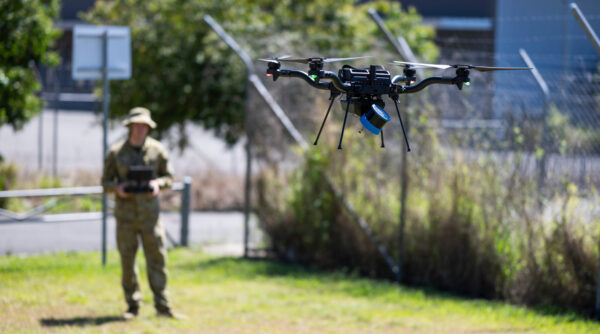The ADF divided its vision into five ‘domains’ – land, sea, air, cyber and space. The basic target for each domain is spelt out:
Navy: boost its strike power with more surface ships and nuclear-powered submarines.
Army: boost its amphibious landing capabilities.
Air force: boost air support through a modern strike force and unmanned drones.
Cyber: boost defence and electronic warfare capabilities.
Space: improve communication capabilities.
The strategy document goes into a more detailed breakdown of how much will be spent on what with $330 billion due to be spent from now to 2033-34. Major spending projects include, but are not necessarily listed here:
- Undersea ($63-$76bn): Nuclear-power submarines, uncrewed subsea warfare and the Ghost Bat robot submersible.
- Surface sea ($51-69bn): New Hunter class and general purpose frigates and Hobart class air warfare destroyers.
- Amphibious capability ($36-44bn): More landing craft, troop and reconnaissance vehicles, helicopters and Abrams tanks.
- Aircraft ($28-33 billion): 20 new C-130J Super Hercules, 72 F-35A JS fighters, EA-18G Growler (electronic warfare), unmanned aircraft and air-to-air missiles.
- Missile defence ($14-18bn): E7-A Wedgetail aircraft (a modified Boeing 737) and other airborne warning aircraft, Jindalee radar network and missile defences.
- Theatre logistics ($15-$21bn): Greater fuel supplies protection and more mobile transport and supply in the operational theatre (including medical care).
- Theatre command ($11-15bn): Land, sea and air command, air traffic management and communications.
- Missiles and ammunition ($16-$21bn): Develop domestic ammunition production facilities and the Guided Missile Launch Rocket System
- Northern bases ($14-18 billion): Develop northern Australia (WA, NT, Qld) bases, logistics network and training areas.
Who’s getting what
A more detailed list of selected projects dating from January 2024 to January 2025 is headlined by the AUKUS pact and naval shipbuilding. Drone, robotic and next generation warfare projects were not included.
NAVY
Eight new British-designed, Australian-built, American enhanced nuclear-power submarines (AUKUS Pillar 1. Australia to buy three Virginia-class subs from the US with an option for two more. Cost: $268-$368bn. This includes:
- upgrading HMAS Stirling base in WA (with new submarine training centre). Cost: $8bn
- upgrade Osburne shipyards in South Australia. Cost: $4bn
- upgrade125 defence and supply chain businesses. Cost: $262m (two years);
- Extending the life of the current Collins class submarines: $4-$5 billion.
- 10-year naval shipbuilding plan that will create a 30-year pipeline of construction projects, largely across South Australia and Western Australia. Cost: $159 billion
- training and retaining a nuclear submarine workforce involving 20,000 jobs over 30 years. Cost: $250m.
- more than 200 new US Tomahawk Cruise missiles for ships and new submarines. Cost: $1.3bn.
- new defence precinct at Henderson, WA, to serve as home dock for Australian, UK and US submarines. Cost: $127m (planning and feasibility).
AIR FORCE
- RAAF’s F35 Lightning fleet now at full strength with 72 aircraft based at RAAF Williamtown (NSW) and RAAF Tindal (NT). Cost: $16 billion (tentative).
- 20 new C-130J Super Hercules. Cost: $9.8 bn;
- Joint Aust-US upgrade of NT training areas and bases. Total cost: $747m
ARMY
- New training facilities at Shoalwater Bay Training Area for Singapore Armed Forces (SAF). Up to 6500 SAF troops can exercise up to nine-weeks at a time. New facilities include two urban live-fire facilities, combined air-land ranges, camp quarters for 2000 personnel and support facilities (medical, admin, exercise control). Cost: N/A
- 75 new Abrams battle tanks from the US. Cost: $3.5 billion. (27 delivered)
- 40 new UH-60M Black Hawk helicopters by 2030 with 12 already delivered.
EARLIER: Annual Defence report under parliamentary scrutiny

Corporal Sam Kelly prepares an aerial LIDAR (Light Detection and Ranging unit) for a test flight. Photo: Department of Defence.







